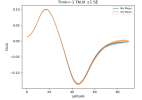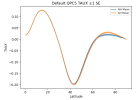Hi,
I'm running prescribed-ocean aquaplanet simulations (QPC5) with different SST distributions for 10 years. The SSTs are defined by changing parameters in the QOBS analytic function (rather than supplying a file). Whilst the input SSTs are symmetrical, I keep getting hemispherically-asymmetric outputs: e.g., wind stress TAUX in the southern hemisphere is not equal to in the northern hemisphere. The asymmetry is also visible for other variables, such as U (which gets more asymmetrical with higher altitude).
The pattern of asymmetry -- that TAUX is stronger at higher latitudes in the southern hemisphere -- is almost always the same for different distributions. This asymmetry is also visible for the default control run without changing the input SST distribution.
I thought the discontinuity in the QOBS distribution's SST gradient might affect things, so I ran a Gaussian temperature distribution and the pattern of asymmetry is the same.
Does anyone have any ideas on this?
Thank you in advance.
I'm running prescribed-ocean aquaplanet simulations (QPC5) with different SST distributions for 10 years. The SSTs are defined by changing parameters in the QOBS analytic function (rather than supplying a file). Whilst the input SSTs are symmetrical, I keep getting hemispherically-asymmetric outputs: e.g., wind stress TAUX in the southern hemisphere is not equal to in the northern hemisphere. The asymmetry is also visible for other variables, such as U (which gets more asymmetrical with higher altitude).
The pattern of asymmetry -- that TAUX is stronger at higher latitudes in the southern hemisphere -- is almost always the same for different distributions. This asymmetry is also visible for the default control run without changing the input SST distribution.
I thought the discontinuity in the QOBS distribution's SST gradient might affect things, so I ran a Gaussian temperature distribution and the pattern of asymmetry is the same.
Does anyone have any ideas on this?
Thank you in advance.



